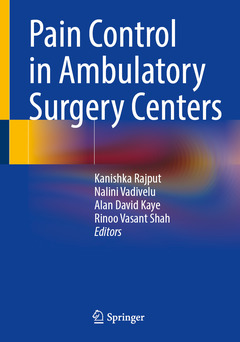Description
Pain Control in Ambulatory Surgery Centers, 1st ed. 2021
Coordinators: Rajput Kanishka, Vadivelu Nalini, Kaye Alan David, Shah Rinoo Vasant
Language: English
Subject for Pain Control in Ambulatory Surgery Centers:
430 p. · 17.8x25.4 cm · Paperback
Description
/li>Contents
/li>Biography
/li>Comment
/li>
This book provides a comprehensive review of the challenges, risk stratification, approaches and techniques needed to improve pain control in ambulatory surgery centers (ASCs). It addresses not only the management of acute perioperative pain but also describes modalities that could potentially reduce the risk of evolution of acute pain into chronic pain, in addition to weaning protocols and follow ups with primary surgical specialties and pain physicians as needed.
Organized into five sections, the book begins with the foundations of managing ASCs, with specific attention paid to the current opioid epidemic and U.S. policies relating to prescribing opioids to patients. Section two and three then explore facets of multimodal analgesia and non-operating room locations, including the use of ultrasounds, sedation in specific procedures, regional anesthesia, ketamine infusions, and the management of perioperative nausea and intractable pain in outpatient surgery. Section four examines the unique challenges physicians face with certain patient demographics, such as the pediatric population, those suffering from sleep apnea, and those with a history of substance abuse. The book closes with information on discharge considerations, ambulatory surgery protocols, recovery room protocols, and mandatory pain management services.
An invaluable reference for all health personnel and allied specialties, Pain Control in Ambulatory Surgery Centers (ASCs) meets the unmet need for a resource that covers optimum pain control in patients undergoing outpatient surgery as well as the urgent ASCs challenges that are presented on an immense scale with national and international impact.
Kanishka Rajput
Department of Anesthesiology
Division of Pain MedicineYale University School of Medicine
New Haven, CT
Nalini Vadivelu
Department of Anesthesiology
Division of Ambulatory Surgery
Yale University School of Medicine, New Haven, CT
Alan David Kaye
Louisiana State University Health Sciences Center
Shreveport, LA
Rinoo Vasant Shah
Louisiana State University Health Sciences Center
School of MedicineShreveport, LA




